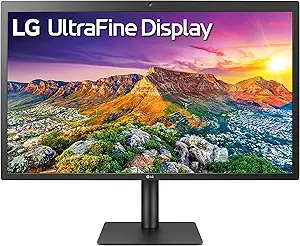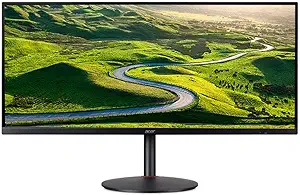In today's digital age, a quality monitor is essential for an immersive computing experience, whether it's for work, gaming, or entertainment. Two prominent contenders in the monitor market are LG and Acer, each offering a range of displays with unique features and specifications. In this article, we'll delve into the strengths and weaknesses of LG and Acer monitors, helping you make an informed decision on which brand suits your needs best.
Key Features Comparison
Response Time
Acer monitors and LG monitors are both reputable brands in the technology market, each with their own strengths when it comes to response time. Acer, for instance, has made a name for itself with its Predator series, which boasts a swift response time of 1ms. This is a significant advantage for gamers who require quick, smooth, and uninterrupted gameplay. The Acer Predator X27, for example, uses the latest In-Plane Switching (IPS) technology to achieve this rapid response time, making it a top choice for competitive gaming. On the other hand, LG monitors, particularly those in the UltraGear lineup, are also known for their impressive response times. The LG UltraGear 27GL850-B, for example, features a 1ms response time thanks to the Nano IPS technology. This monitor is also equipped with a 144Hz refresh rate which further enhances its performance in fast-paced gaming situations. However, it's worth noting that while both brands offer monitors with 1ms response times, some users have reported a slight motion blur in LG monitors when running at this speed. This might be a minor disadvantage for LG when compared to Acer, especially for professional gamers who require precision and clarity. However, for the average user, this difference may not be noticeable. Both brands are competitive in terms of response time, and the choice between them often comes down to personal preference and specific requirements.
Panel Type
Acer and LG monitors, two of the leading brands in the market, offer a range of panel types that significantly impact the display quality, color accuracy, and viewing angles. Acer monitors predominantly use Twisted Nematic (TN), In-Plane Switching (IPS), and Vertical Alignment (VA) panels. TN panels are known for their high refresh rates and low response times, making them suitable for gaming. However, they fall short in color accuracy and viewing angles. IPS panels, on the other hand, offer excellent color accuracy and wide viewing angles, but they have slower response times. VA panels strike a balance between TN and IPS, offering better color accuracy than TN panels and faster response times than IPS panels. LG monitors, on the other hand, widely use IPS panels in their product line. LG's IPS panels, equipped with the latest Nano IPS technology, offer a color gamut that covers 98% of the DCI-P3 color space, making them ideal for professional photo and video editing. They also offer wide viewing angles with minimal color shift. However, they may not be as responsive as TN panels, which might be a drawback for gamers. Compared to Acer, LG has less variety in panel types, but their IPS panels are considered among the best in the industry. Both brands offer monitors with high refresh rates and low response times, but the choice between them would depend on the specific needs of the user, whether it's gaming, professional work, or general use.
Affordability
When it comes to the aspect of price in the category of monitors, both Acer and LG offer a wide range of options to cater to various budget segments. Acer monitors are generally known for their affordability, making them a popular choice among budget-conscious consumers. The brand offers a variety of monitors, including the latest Acer R240HY, which is an affordable 23.8-inch IPS monitor with a zero-frame design. It is a cost-effective option for those who need a monitor for general use or casual gaming. On the other hand, LG monitors are slightly higher in price but are often justified by the advanced features and superior technology they offer. For instance, the LG 27UK850-W is a 27-inch 4K UHD IPS monitor that comes with HDR10 compatibility and USB Type-C connectivity, which are features typically found in higher-end monitors. Despite the higher price tag, LG monitors are praised for their excellent color accuracy, sharp image quality, and innovative features. However, when compared to other brands in the same price range, such as Dell or Asus, LG monitors often offer better value for money due to these advanced features.
Reputation
Acer and LG are both highly reputable brands in the monitor market, each with their own strengths and areas of specialization. Acer is well-known for its gaming monitors, particularly the Predator and Nitro series. These monitors are equipped with the latest technologies such as fast refresh rates, low response times, and NVIDIA G-Sync or AMD FreeSync compatibility, making them a favorite among gamers. Acer monitors are also praised for their robust build quality and innovative designs. However, some users have reported issues with customer service and product longevity. On the other hand, LG is renowned for its high-quality IPS panels, which offer wide viewing angles and excellent color accuracy, making them ideal for professional use in graphic design and video editing. LG’s UltraFine series, for example, is highly regarded for its 4K and 5K displays. LG monitors also feature advanced technologies like HDR10 for enhanced detail and color depth. While LG monitors are generally more expensive than Acer monitors, they are often praised for their sleek design, reliable performance, and superior customer service. However, some users have noted that LG monitors may not be as well-suited for gaming due to slower response times and refresh rates compared to Acer's gaming-focused models.
Picture Quality
When it comes to picture quality, both Acer and LG monitors offer a range of options that cater to different user needs. Acer monitors, particularly those in the Predator and Nitro series, are well-regarded for their high refresh rates and resolution. They feature technologies like Visual Response Boost (VRB) for reducing blur in fast-moving scenes and Quantum Dot technology for a wider color gamut, resulting in vibrant and crisp images. However, some users have reported issues with color accuracy, which can be a downside for graphic designers and digital artists. On the other hand, LG monitors, especially those in the UltraFine and UltraGear series, are known for their outstanding picture quality. They use In-Plane Switching (IPS) technology that ensures accurate colors and wide viewing angles. Moreover, some LG models feature 4K and 5K resolutions, HDR10 support, and even color calibration for professional use. This results in superior image quality with deep blacks and bright whites. However, they tend to be more expensive than Acer monitors and their high-resolution models may require more powerful hardware to fully take advantage of their capabilities. Compared to other brands, both Acer and LG offer competitive picture quality, but the choice between the two often comes down to specific user requirements and budget.
Production Selection
Acer and LG are two prominent brands in the monitor market, each offering a wide selection of products to cater to different users' needs. Acer's product range includes budget-friendly options, gaming monitors, and professional-grade displays. The brand is known for incorporating the latest technologies in their products, such as HDR, high refresh rates, and adaptive sync technologies like G-Sync and FreeSync. Acer's Predator series, for instance, is highly acclaimed in the gaming community for its performance and features. However, Acer monitors often receive criticism for their build quality and longevity compared to other brands. On the other hand, LG's selection of monitors is equally diverse, featuring products for everyday use, professional work, and gaming. LG's UltraFine series, for example, is renowned for its exceptional color accuracy and resolution, making it a favorite among graphic designers and video editors. LG monitors often incorporate cutting-edge technologies like Nano IPS, HDR10, and Thunderbolt 3 connectivity. They are also generally praised for their sleek design and robust build quality. However, LG monitors tend to be more expensive than Acer's, which may deter budget-conscious consumers. Both brands offer a comprehensive selection of monitors, but the choice between them ultimately depends on the specific needs and budget of the user.
Related Video
Conclusion
Acer and LG are both renowned brands in the monitor market, each with their own strengths and weaknesses. Acer monitors, particularly the Predator series, are known for their high refresh rates and low response times, making them ideal for gaming. Acer also offers a wide range of monitors to cater to different user needs, from basic office monitors to high-end gaming displays. They are also known for their affordability, offering good value for money. However, Acer monitors are often criticized for their build quality and durability. On the other hand, LG monitors, especially the UltraFine series, are highly regarded for their exceptional color accuracy and resolution, making them perfect for professional graphic designers and video editors. LG monitors also feature the latest technologies such as Nano IPS technology and Thunderbolt 3 connectivity. They are also known for their sleek design and superior build quality. However, LG monitors tend to be more expensive, and their gaming monitors may not offer as high refresh rates as those from Acer. Comparing the two, Acer might be more suitable for gamers and budget-conscious consumers, while LG is more tailored towards professionals seeking high-quality displays.



















